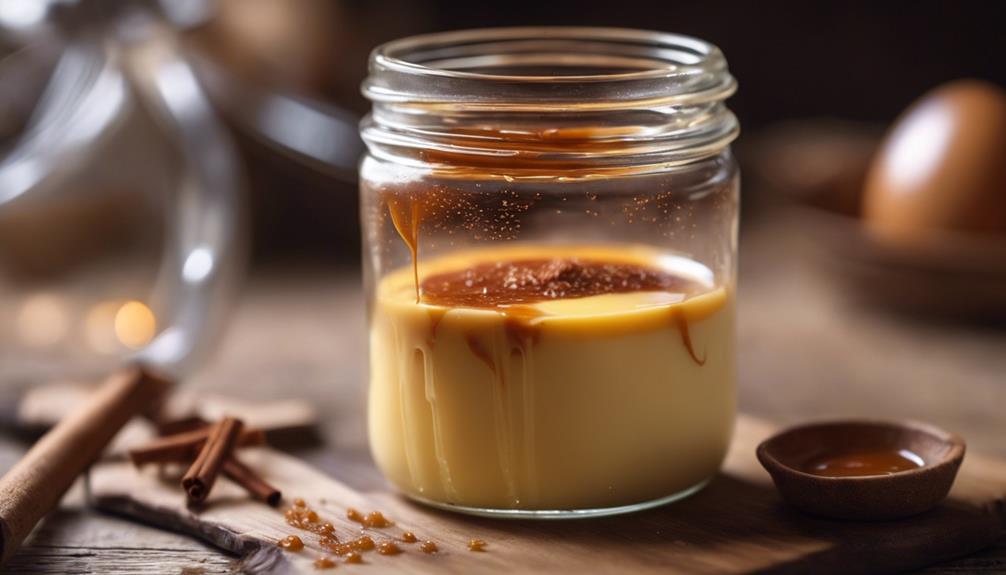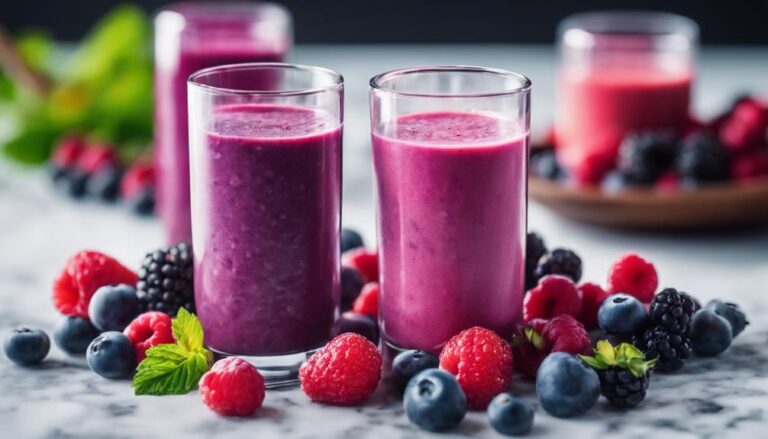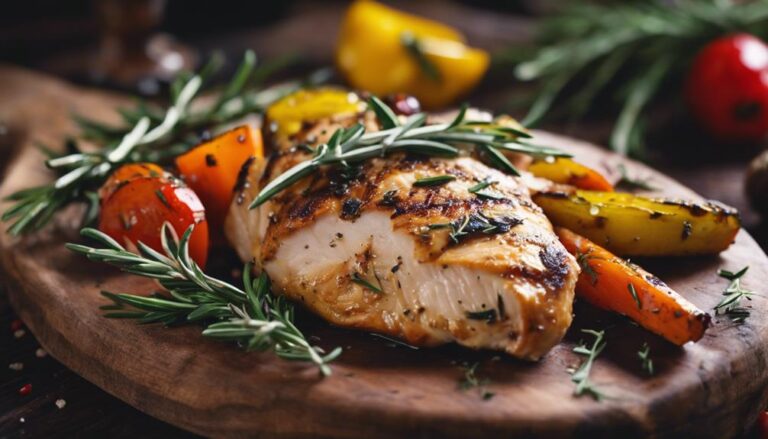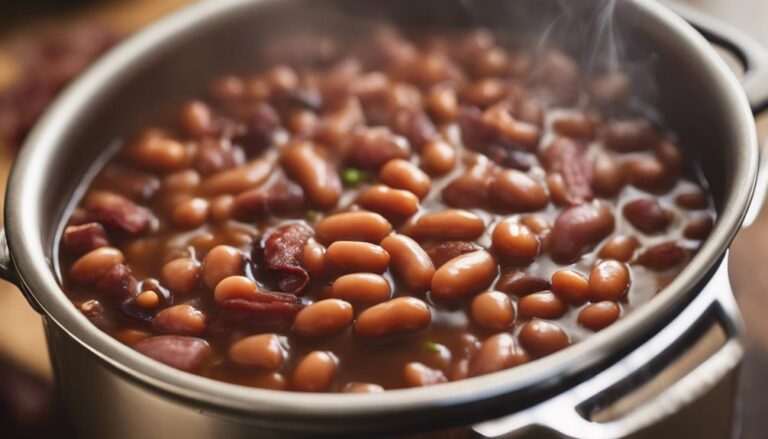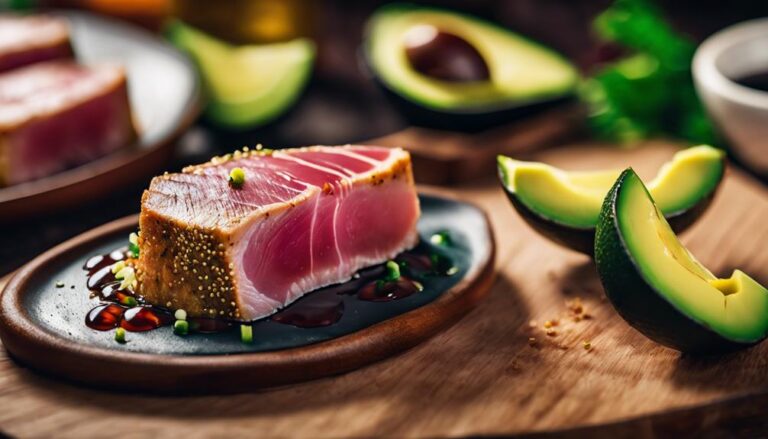Sous Vide Egg Custard
To create a delectable sous vide egg custard, set your sous vide machine to 176°F (80°C). Slowly heat the custard mix to avoid curdling, cooking for 1-1.5 hours for a gentle egg set. Stir gently for a consistent texture. Adjust the egg to liquid ratio for your desired thickness. More eggs or less liquid give a thicker custard, while fewer eggs or more liquid provide a lighter texture. For a creamy texture, cook at approximately 167°F (75°C) for 1-2 hours. Strain the mixture before cooking and use quality ingredients. Achieve velvety smoothness and perfect thickness with sous vide.
What You Will Learn Here
- Use a sous vide machine set at 176°F for perfect custard texture.
- Slowly heat custard to prevent curdling during cooking.
- Cook custard for 1-1.5 hours for gentle egg setting.
- Incorporate gentle stirring for a uniform consistency.
- Achieve a luscious texture by following precise temperature and cooking duration guidelines.
Egg Custard Origins
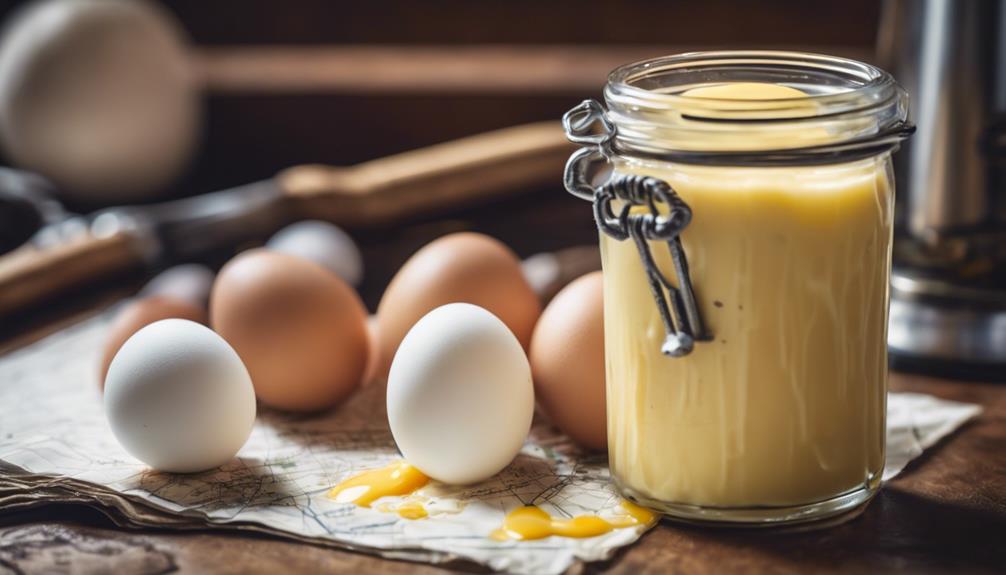
Egg custards have a rich history, with variations found in different cultures worldwide.
You can explore the traditional ways these custards were made and how they've evolved over time.
From ancient recipes to modern twists, the journey of egg custards is fascinating and delicious.
Historical Egg Custards
Delving into the origins of custards reveals a rich culinary history intertwined with various cultures and traditions. Egg custards, often traced back to ancient Rome, were considered a luxurious delicacy enjoyed by the elite. The Romans flavored their custards with honey and bay leaves, setting a precedent for the sweet custards enjoyed today. As culinary practices spread throughout Europe, custards evolved to include a wider array of ingredients such as milk, sugar, and eggs.
During the Middle Ages, custards gained popularity across Europe, becoming a staple in royal feasts and banquets. The custard's smooth texture and rich flavor made it a favorite dessert among nobility. Over time, different regions developed their variations, incorporating local ingredients and culinary techniques.
Cultural Variations
Exploring the cultural variations in egg custard origins reveals a tapestry of culinary influences and traditions from around the world. Egg custard, a delicate and creamy dessert enjoyed in many cultures, has diverse origins that reflect each region's unique culinary history.
In France, the classic Crème Brûlée stands out with its rich custard base and caramelized sugar top, showcasing the French expertise in decadent desserts. Moving to Portugal, the Pastéis de Nata captivate with their flaky pastry and creamy custard filling, offering a taste of Portuguese craftsmanship.
Asian countries like China and Japan have their versions of egg custards. In China, the silky-smooth Dan Tat showcases the delicate balance of sweet and savory flavors, while Japan's Chawanmushi presents a savory twist with a steamed egg custard infused with dashi and soy sauce.
Each cultural variation of egg custard brings a unique taste and texture, reflecting the culinary diversity and creativity of different regions around the globe.
Modern Egg Custard
As we shift our focus to modern egg custard, consider the evolution of this beloved dessert and its roots in various culinary traditions worldwide. Egg custard has a rich history that spans centuries and continents. The modern version of egg custard that we enjoy today has been influenced by a variety of cultural practices and cooking techniques.
In Western cuisine, egg custard has its origins in medieval European kitchens, where custards were popularized as delicate desserts among the nobility. Over time, this dessert spread across the globe through trade and exploration, adapting to local ingredients and flavor preferences along the way.
In Asian cultures, egg custard has a long-standing presence in traditional desserts and savory dishes. Chinese, Japanese, and Filipino cuisines, among others, feature variations of egg custard that highlight the delicate texture and subtle sweetness of this versatile dish.
Whether enjoyed as a comforting dessert or a sophisticated treat, modern egg custard continues to captivate taste buds around the world, showcasing the enduring appeal of this simple yet delightful culinary creation.
Key Custard Components
To understand the essence of a perfect sous vide egg custard, focus on its fundamental components. When crafting this delicate dessert, each ingredient plays an essential role in achieving the desired taste and texture. Here are the key custard components to pay attention to:
- Eggs: The main ingredient in any custard, eggs provide the rich and creamy base essential for a velvety texture. The proteins in the egg yolks coagulate during cooking, giving the custard its structure and smooth consistency.
- Dairy: Dairy products like milk or cream add richness and depth to the custard. The fat content in dairy enhances the mouthfeel and contributes to the custard's luxurious taste. Choosing high-quality dairy can elevate the overall flavor of the dessert.
- Sweetener: Whether it's sugar, honey, or another sweetening agent, the sweetener balances the flavors in the custard. It not only adds sweetness but also helps in achieving the desired level of caramelization during cooking, enhancing the color and taste of the custard.
Top Custard Creations
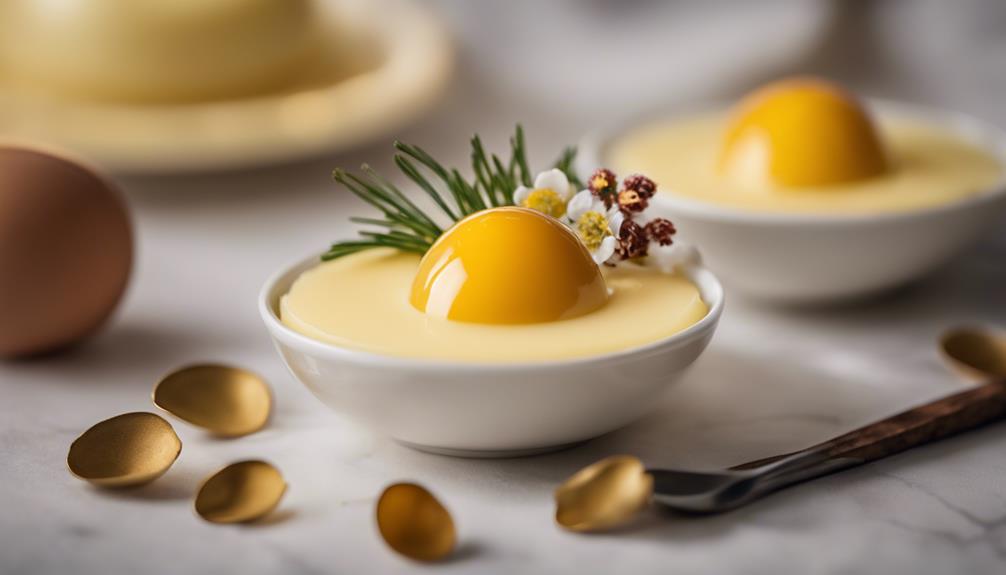
When it comes to custard creations, you have a variety of delicious options to choose from. Whether you prefer a velvety Sous Vide Custard, a creamy Creme Brulee Recipe, or a light and airy Egg Custard Souffle, there's something for every custard enthusiast.
These top custard creations offer a perfect balance of rich flavors and silky textures that are sure to satisfy your dessert cravings.
Velvety Sous Vide Custard
Indulge in the luscious texture of velvety sous vide custard, a top contender among custard creations. Here are three reasons why this custard variation stands out:
- Perfectly Creamy: Sous vide cooking guarantees a consistently smooth and creamy texture throughout the custard, with no risk of curdling or overcooking.
- Enhanced Flavor Infusion: By sealing the custard in a bag and cooking it in a water bath at precise temperatures, the flavors meld together beautifully, resulting in a rich and decadent taste.
- Uniform Cooking: The sous vide method offers precise temperature control, cooking the custard evenly from edge to center, ensuring a silky, velvety consistency that traditional methods often struggle to achieve.
Velvety sous vide custard provides a luxurious dessert experience that's sure to impress. Whether enjoyed on its own or paired with fruits or a drizzle of caramel, this custard variation promises a delightful treat for your taste buds.
Creamy Creme Brulee Recipe
Bringing a delightful crunch to complement its creamy interior, the Creamy Creme Brulee Recipe is a standout among top custard creations. If you're looking to indulge in a luxurious dessert experience, this recipe is a must-try. Here's why you should give it a go:
- Contrasting Textures: The Creamy Creme Brulee Recipe offers a perfect blend of textures – the smooth, velvety custard base contrasts beautifully with the crisp caramelized sugar topping.
- Decadent Flavor: With its rich vanilla-infused custard and the satisfying crack of the caramelized sugar crust, this dessert is a symphony of flavors that will tantalize your taste buds.
- Impressive Presentation: Creme Brulee isn't only a delight for your palate but also a feast for your eyes. The golden-brown caramelized top creates an elegant and sophisticated presentation that's sure to impress your guests.
Indulge in the Creamy Creme Brulee Recipe for a dessert experience that's both sophisticated and satisfying.
Egg Custard Souffle
For a delightful twist on traditional custard desserts, consider trying the Egg Custard Souffle, a top custard creation that promises a light and airy texture. When making this delectable treat, keep in mind the following tips to guarantee a successful outcome:
- Whisking: Start by whisking the egg yolks and sugar until they're pale and fluffy. This step is essential for incorporating air into the mixture, which contributes to the souffle's lightness.
- Folding: Gently fold the whipped egg whites into the egg yolk mixture to maintain the airy consistency. Avoid overmixing to protect the souffle's fluffy texture.
- Baking: Bake the souffle in a preheated oven until it rises and turns golden brown on top. Be mindful of the baking time to achieve the perfect balance between a set custard bottom and a fluffy souffle top.
Custard Consistency Tricks
To achieve the perfect custard consistency, you can follow some simple tricks.
Start by mastering the secrets to a smooth texture.
Then move on to tips for achieving the ideal thickness.
Smooth Texture Secrets
To achieve a velvety smooth texture in your egg custard, focus on precise cooking temperatures and gradual heating techniques. Maintaining a critical temperature is essential when preparing custard. Use a sous vide machine to control the water temperature precisely. Set it to 176°F (80°C) for a creamy custard consistency. Slowly heating the custard mixture helps prevent curdling and guarantees a silky smooth texture.
Another key factor in achieving a smooth custard is the cooking time. Cook the custard mixture for about 1-1.5 hours to allow the eggs to set gently. This slow cooking process helps develop a luxurious mouthfeel. Be patient and resist the urge to rush the cooking time, as it can impact the final texture.
Additionally, incorporating a gentle stirring technique during cooking can help distribute the heat evenly and prevent any lumps from forming. Use a light hand and stir the custard mixture occasionally to promote a uniform consistency. By paying attention to these smooth texture secrets, you can elevate your egg custard to a decadent dessert experience.
Perfect Thickness Tips
Achieve the perfect thickness in your custard by adjusting the ratio of eggs to liquid in your recipe. The number of eggs and the amount of liquid you use play a vital role in determining the consistency of your custard. For a thicker custard, increase the number of eggs or reduce the amount of liquid. On the other hand, if you prefer a lighter texture, you can decrease the number of eggs or increase the liquid in your recipe. Finding the right balance is key to achieving a custard that isn't too runny or too firm.
Experimenting with different ratios of eggs to liquid can help you customize the thickness of your custard to suit your preferences. Keep in mind that the cooking time and temperature also affect the final consistency, so make sure to adjust these factors accordingly. By paying attention to the egg-to-liquid ratio and making small adjustments as needed, you can create a perfectly thick custard every time.
Creamy Consistency Hacks
For a creamier custard consistency, focus on mastering the cooking temperature and duration. When preparing your sous vide egg custard, setting the temperature precisely is important. Aim for around 167°F (75°C) for a velvety texture. Cooking the custard too hot can result in curdling, while cooking it too low may not set properly. The duration of cooking also plays a key role. Typically, custards are cooked for 1 to 2 hours to achieve that perfect creamy consistency. However, the exact time may vary based on the recipe and personal preference.
Another hack for achieving a creamy custard is to use high-quality ingredients. Opt for fresh eggs, dairy, and flavorings for the best results. Straining your custard mixture before cooking can also help ensure a smooth texture free of any lumps. Additionally, consider experimenting with different ratios of egg to cream to find the perfect balance for your ideal custard consistency. By paying attention to these details and making small adjustments as needed, you can elevate your sous vide egg custard to a new level of creaminess.
Final Thoughts

In wrapping up your exploration of the Sous Vide Egg Custard recipe, consider the delightful versatility of this custard as a base for various toppings or mix-ins. The beauty of this custard lies not only in its creamy consistency but also in its adaptability to suit a wide range of flavor profiles. Whether you prefer a classic pairing like caramel drizzle and sea salt or a more adventurous combination such as fresh berries and balsamic reduction, the Sous Vide Egg Custard serves as a blank canvas for your culinary creativity.
As you reflect on your sous vide cooking journey with this egg custard, remember that precision and patience are key. The slow, gentle cooking process yields a velvety texture that's hard to achieve through traditional methods. Embrace the simplicity of the ingredients – eggs, cream, sugar – and how they come together to create a decadent treat that's both comforting and elegant.
Frequently Asked Questions
Can I Use Whole Eggs Instead of Just Yolks for the Custard?
Yes, you can use whole eggs instead of just yolks for the custard. This will result in a slightly different texture and flavor profile but is a perfectly acceptable variation to try.
How Can I Prevent a Skin From Forming on Top of the Custard?
To prevent a skin from forming on top of the custard, cover it with plastic wrap directly touching the surface. This creates a barrier that stops air exposure, maintaining the custard's smooth texture. Refrigerate to set.
What Is the Best Way to Store Leftover Custard?
To store leftover custard, refrigerate it in an airtight container. Make sure the custard is cooled before storing. Use within 3-4 days for best freshness. When ready to enjoy, gently reheat the custard for a delicious treat.
Can I Add Other Flavors Like Chocolate or Fruit to the Custard?
You can definitely add other flavors like chocolate or fruit to custard. Experiment with different combinations to find what you enjoy most. Just make sure the additional ingredients are well incorporated for a delicious twist.
Is It Possible to Make a Dairy-Free Version of Egg Custard?
Yes, you can make a dairy-free version of egg custard by using alternative milk like almond or coconut milk. Swap out regular milk for a non-dairy option to create a creamy, lactose-free custard.
Conclusion
To sum up, sous vide egg custard is a delectable and versatile dessert that can be enjoyed in various forms.
By understanding the origins and key components of custard, as well as learning some tricks for achieving the perfect consistency, you can create a custard that will impress your friends and family.
Whether you prefer a classic custard or a unique variation, experimenting with different ingredients and techniques can lead to endless possibilities for this timeless dessert.
